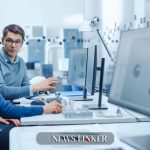A striking image captured by the NASA/ESA Hubble Space Telescope reveals the transformative influence of young stars on a distant nebula. The nebula, known as RCW 7, is situated approximately 5,300 light-years from Earth in the constellation Puppis. This image showcases an array of interstellar gas and dust, creating a celestial landscape that is both intricate and luminous.
Formation of Protostars
The Role of H II Regions
Nebulae like RCW 7 are dense with the materials necessary for star formation. Under gravitational forces, sections of these molecular clouds collapse, forming protostars—young stars still enveloped in rotating discs of gas and dust. The stars developing within RCW 7 are notably massive, generating intense ionizing radiation and stellar winds that convert the nebula into an H II region. This process is marked by the presence of hydrogen ions, which emit light that gives the nebula its distinctive pinkish hue.
Hubble’s image data originates from a study focused on a significant protostellar binary named IRAS 07299-1651, enveloped in a glowing gas cocoon within the nebula. By employing the Wide Field Camera 3 in near-infrared light, astronomers were able to peer through the nebula’s gas and dust, revealing the protostars. These massive stars emit predominantly in ultraviolet light but also in infrared, which can penetrate the nebula’s dense clouds.
The formation of an H II region signifies the beginning of the end for molecular clouds like RCW 7. Over several million years, radiation and winds from the massive stars will gradually disperse the nebula’s gas. The most massive stars will eventually end their lives in supernova explosions, further contributing to the dispersion. New stars that form in this nebula will incorporate only a fraction of its gas, with the remainder spreading throughout the galaxy to create new molecular clouds.
In previous research, nebulae such as RCW 7 have been studied extensively to understand the lifecycle of stars. These studies often emphasize the dynamic interactions between stars and their surrounding environment. The role of H II regions is a critical aspect of this research, providing insights into how stellar radiation influences nebular structures. The current findings build on this foundation, offering a more detailed view of the processes at play within RCW 7.
Earlier observations by various space telescopes have highlighted the intricate dance of star formation and destruction within nebulae. The Hubble Space Telescope‘s latest image adds depth to our understanding by capturing the transformation of RCW 7’s molecular cloud. This transformation not only shapes the nebula’s appearance but also dictates the future distribution of its gas and dust, which are essential for forming new stars and planetary systems.
The observation of RCW 7 by Hubble underscores the continuous cycle of star formation and molecular cloud evolution within our galaxy. By examining RCW 7 in detail, scientists can better comprehend the processes that govern star formation and the eventual dispersal of nebular material. This knowledge is crucial for understanding the broader mechanisms that drive the evolution of galaxies and the universe.
Hubble’s ability to capture such detailed images of nebulae like RCW 7 allows astronomers to study the intricate processes of star formation and nebular transformation. These observations help in comprehending the life cycles of stars and the dynamic nature of molecular clouds. The insights gained from Hubble’s observations contribute significantly to our understanding of the universe and its continuous evolution.










